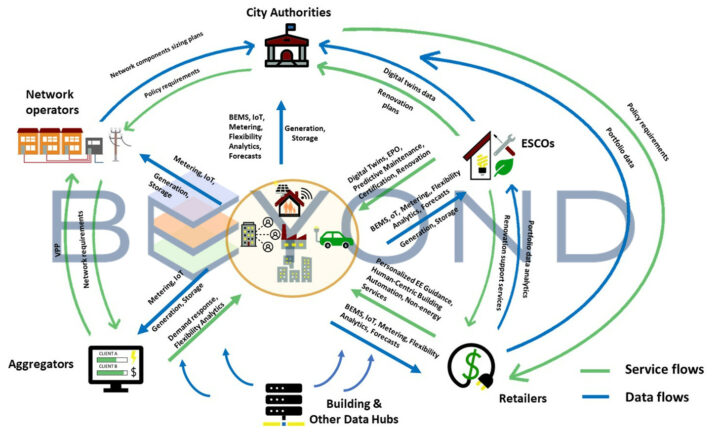The BEYOND H2020 project builds a platform that will not only facilitate the provision of energy related services among energy stakeholders and buildings but will also include the whole infrastructure for the acquisition, curation and sharing of the respective data along with the corresponding data markets.

Reasonably, an unfamiliar with the energy landscape person would ask: Who are the main actors here? For BEYOND platform, we define the possible roles in a dual-axis classification: (i) Horizontal data-related roles and (ii) Roles within the energy value chain. This classification supports the idea that each stakeholder belongs to a category on both axes at the same time. In terms of data-related roles, we assume we have data owners / providers, data intermediaries, and data consumers that we will discuss in a later post
Modern energy-related actors around buildings
The landscape around energy production, transportation, distribution and consumption has changed a lot in recent decades. It is increasingly decentralized and has also incorporated technologies around renewable energy sources. However, for many people in the public this change may not yet be immediately visible, so the purpose of this post is to give an overview of their responsibilities and activities. You are ready to see the most important players in the energy sector, you may be surprised!
City authorities
When talking about the city authorities, we refer to the local city governance who is responsible for the decision-making regarding the implementation of innovations and their maintenance at city-level. The city schedule includes, among others, the urban energy policy planning aiming at the city transformation to a smart and sustainable ecosystem. The optimization of these policies require feedback derived by data or analytics provided by multiple sources inside the city e.g., the characterization and prediction of heavy loads from lighting, building demand/generation, etc.
Building Managers
They are responsible for the operational maintenance of the main assets of a building, and the comfort and well-being conditions of the building occupants, both at the lowest possible cost. In order to do so, they require a wide range of data and analytics that represent the present conditions in the building, predictions concerning the maintenance activities to be scheduled in the near future, but also historic data for the evaluation of the present operations and conditions.
Building occupants
They are the energy consumers, and they care mostly for the reduction of the energy cost which can be achieved not only with a demand reduction. An increased awareness and understanding of their consumption pattern can enable them to deliver flexibility services to retailers and network operators who can find added value to the acquisition of data concerning the building demand profile concerning their scheduling and operational management. The exchange of such data is not yet widely used, so the occupants can prove sceptical to such a perspective. The same applies to the participation in the flexibility markets, which is yet common only to the industrial sector.
Network Operators
They are responsible for the smooth operation of the electricity distribution system (DSOs) or the district heating network (District Heating Network Operators) considering that every moment the input of the system should be able to satisfy the demand. Bearing that the demand has peaks that affect both the cost of the energy and the sustainability of the system, it is very important for them to accurately forecast the demand and to make any necessary modifications and fine tuning in order to balance offer and demand. They are responsible for the system management, so the definition and development of the energy markets is performed according to their need to satisfy the corrections in the demand forecasting during the day, hour or even instantly. It proves crucial for them to have as accurate demand forecasting as possible to support their level of management, as well as their ability to plan the most suitable mid-and long-term network reinforcement strategies.
Energy suppliers/retailers
The energy retailers manage large portfolios of consumers including the domestic sector and not only large industrial and commercial consumers. They buy energy according to their predictions of their customers’ demand and they pay for the imbalance charges, which represents a considerable cost.
ESCOs & Construction Companies
ESCOs (v) take over the initial construction or renovation of buildings in order to increase the building energy performance which is guaranteed through the signing of Energy Performance Contracts with their customers. They care to be able to accurately appraise the initial energy performance and to find the optimized solution for the highest increase in this performance, at the lowest possible cost.
Aggregators
They represent groups of mostly small energy consumers, prosumers and battery owners in the energy market. They group their portfolios in Virtual Power Plants (VPPs) which have a separate internal energy management having a common generation, consumption and storage. In this way, the imbalances between the generation and consumption of an individual prosumer, are possible to be handled by the reverse imbalances of others. The aggregators exploit flexible loads of their grouped consumers in order to satisfy all demand with self-generated energy. Thus, the network plays less the role of the constant energy supplier, but allows more responsibility for the balance and quality of the energy. This can enable the surpassing of the various barriers and limited capabilities of the prosumers, who find profit through an intermediate aggregator.
BEYOND includes all kind of energy actors. Take a look of them here!






